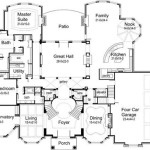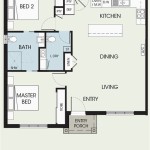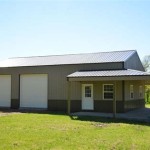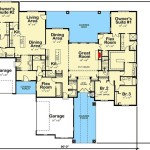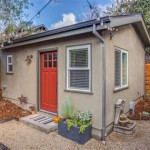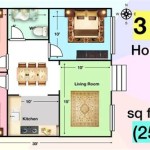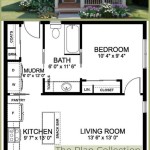Single Floor House Plans: Exploring 4-Bedroom Designs
Single floor house plans, often referred to as ranch-style or rambler homes, provide accessible and convenient living spaces. These plans are particularly attractive to families with young children, individuals with mobility limitations, and those who simply prefer the ease of navigating a home without stairs. A 4-bedroom single floor plan caters to larger families or those who desire extra space for guests, home offices, or hobbies. This article explores the various aspects of 4-bedroom single floor house plans, focusing on their advantages, design considerations, and popular layouts.
The demand for single floor living has steadily increased, driven by an aging population seeking to "age in place" and by the growing popularity of universal design principles. Universal design aims to create homes that are accessible and usable by people of all ages and abilities. Single floor plans inherently lend themselves to universal design, making them a practical and forward-thinking choice.
When considering a 4-bedroom single floor house plan, several factors come into play. These include lot size, budget, desired architectural style, and personal preferences regarding layout and amenities. Careful planning and consideration of these factors are crucial to ensure the final design meets the homeowner's needs and lifestyle.
Key Point 1: Advantages of Single Floor 4-Bedroom House Plans
Single floor living offers numerous advantages that contribute to its widespread appeal. These advantages extend beyond mere convenience and impact various aspects of daily life and home maintenance.
Accessibility: Perhaps the most significant advantage is accessibility. The absence of stairs eliminates a major barrier for individuals with mobility issues, the elderly, and families with young children. Ramps can be easily incorporated at entrances to further enhance accessibility for wheelchair users or those with walkers.
Ease of Maintenance: Single floor homes are generally easier to maintain than multi-story homes. Exterior maintenance, such as window cleaning and gutter cleaning, is simplified. Interior cleaning is also more efficient, as there are no stairs to navigate.
Safety: The absence of stairs reduces the risk of falls, a significant concern for elderly individuals and young children. In the event of a fire or other emergency, evacuation is also simpler and faster.
Open Concept Living: Single floor plans often lend themselves to open concept living, creating a spacious and airy feel. This design style promotes better flow and interaction between different areas of the home, making it ideal for families and entertaining.
Efficient Heating and Cooling: Distributing conditioned air is often more efficient in a single floor home compared to a multi-story home. This can translate to lower energy bills and a more comfortable living environment.
Lower Construction Costs: In some cases, the construction costs of a single floor home can be lower than those of a multi-story home of comparable square footage. This is due to the simplified foundation and framing requirements.
Key Point 2: Design Considerations for 4-Bedroom Single Floor Plans
Designing a functional and aesthetically pleasing 4-bedroom single floor home requires careful consideration of several key design elements. These elements influence the overall layout, flow, and functionality of the space.
Zoning: Zoning refers to the strategic placement of different areas within the home. For a 4-bedroom plan, it's essential to separate the sleeping areas from the living and entertaining areas to provide privacy and minimize noise disruption. Consider grouping the bedrooms together in one wing of the house, while the living room, kitchen, and dining area occupy another zone.
Bedroom Placement: Consider the placement of the master bedroom relative to the other bedrooms. Some homeowners prefer to have the master bedroom separated from the other bedrooms for added privacy, while others prefer to have it located closer to the children's bedrooms for convenience. The ages and needs of the occupants will influence this decision.
Bathroom Layout and Number: The number of bathrooms required will depend on the size of the family and their lifestyle. A 4-bedroom home typically benefits from having at least two bathrooms, with a master bathroom attached to the master bedroom. Consider a layout that allows for easy access to bathrooms from all bedrooms and common areas.
Kitchen Design: The kitchen is often considered the heart of the home, and its design should be given careful consideration. A well-designed kitchen should be functional and aesthetically pleasing, with ample counter space, storage, and efficient layout. Consider incorporating an island or peninsula for additional workspace and seating.
Living Area Design: The living area should be comfortable and inviting, providing a space for relaxation and entertainment. Consider the size and shape of the living area and how it relates to the other areas of the home. Adequate natural light and comfortable seating are essential elements.
Storage Solutions: Adequate storage is crucial in any home, especially a 4-bedroom home. Consider incorporating ample closet space in each bedroom, as well as additional storage areas for linens, cleaning supplies, and other household items. A well-designed storage system can help to keep the home organized and clutter-free.
Natural Light and Ventilation: Maximize natural light and ventilation throughout the home. Large windows and skylights can help to bring in natural light and reduce the need for artificial lighting. Proper ventilation can help to improve indoor air quality and reduce the risk of moisture buildup.
Outdoor Spaces: Incorporate outdoor spaces, such as patios, decks, or porches, to extend the living area and provide opportunities for outdoor relaxation and entertainment. Consider the orientation of the outdoor space to maximize sunlight and privacy.
Key Point 3: Popular 4-Bedroom Single Floor Plan Layouts
Several popular layouts exist for 4-bedroom single floor house plans, each offering unique advantages and catering to different lifestyles. Understanding these common layouts can help homeowners visualize the possibilities and choose a plan that best suits their needs.
Ranch Style: The classic ranch style is characterized by its rectangular shape, low-pitched roof, and attached garage. This layout typically features a long hallway connecting the bedrooms, bathrooms, and living areas. The kitchen is often located at the rear of the house, overlooking the backyard.
Open Concept: Open concept layouts are characterized by a large, open living area that encompasses the living room, dining area, and kitchen. This layout promotes better flow and interaction between different areas of the home, making it ideal for families and entertaining. The bedrooms are typically located off to one side of the house, providing privacy.
Split Bedroom: Split bedroom layouts are designed to separate the master bedroom from the other bedrooms, providing added privacy. The master bedroom is typically located at one end of the house, while the other bedrooms are located at the opposite end. The living areas are located in the center of the house, separating the two bedroom wings.
L-Shaped: L-shaped layouts maximize natural light and views. The house is shaped like an "L," with one wing containing the bedrooms and the other wing containing the living areas. This layout creates a natural courtyard or outdoor living space.
U-Shaped: U-shaped layouts create a central courtyard that can be used for outdoor living, gardening, or simply enjoying the natural surroundings. The house is shaped like a "U," with the bedrooms located on one side, the living areas on the other side, and the kitchen and dining area connecting the two wings.
Courtyard Design: Courtyard designs feature a central courtyard that is enclosed by the house on all sides. This layout provides a private and protected outdoor space. The rooms surrounding the courtyard often have large windows or doors that open onto the courtyard, creating a seamless connection between indoor and outdoor living.
When selecting a 4-bedroom single floor house plan, it's crucial to consider the specific needs and lifestyle of the occupants. Factors such as family size, hobbies, and entertaining habits should be taken into account. Consulting with an architect or home designer can help to create a custom plan that meets all of the homeowner's requirements.
Furthermore, remember to research local building codes and regulations before finalizing any plans. These codes can dictate setbacks, height restrictions, and other design parameters that must be adhered to.
Investing in a well-designed 4-bedroom single floor house plan can provide a comfortable, accessible, and functional living space for years to come. Careful planning and attention to detail are essential to ensure that the final design meets the homeowner's needs and lifestyle.

Contemporary Plan 4 211 Square Feet Bedrooms 5 Bathrooms 5565 00151

Pin Page

Minimalist Single Story House Plan With Four Bedrooms And Two Bathrooms Cool Concepts

One Story 4 Bedroom Farm House Style Plan 8817

4 Bedroom House Plan Examples

Archimple 4 Bedroom House Plans Single Story Choose Your Dream Home

House Plan 201024 Single Story 4 Bedrooms 2 5 Bathrooms Floor Instant Custom Plans Service

Pin Page

Four Bedroom One Story House Plan 82055ka Architectural Designs Plans

Peace And Quiet House Plan One Story Modern Home Design Mm 2316
See Also

